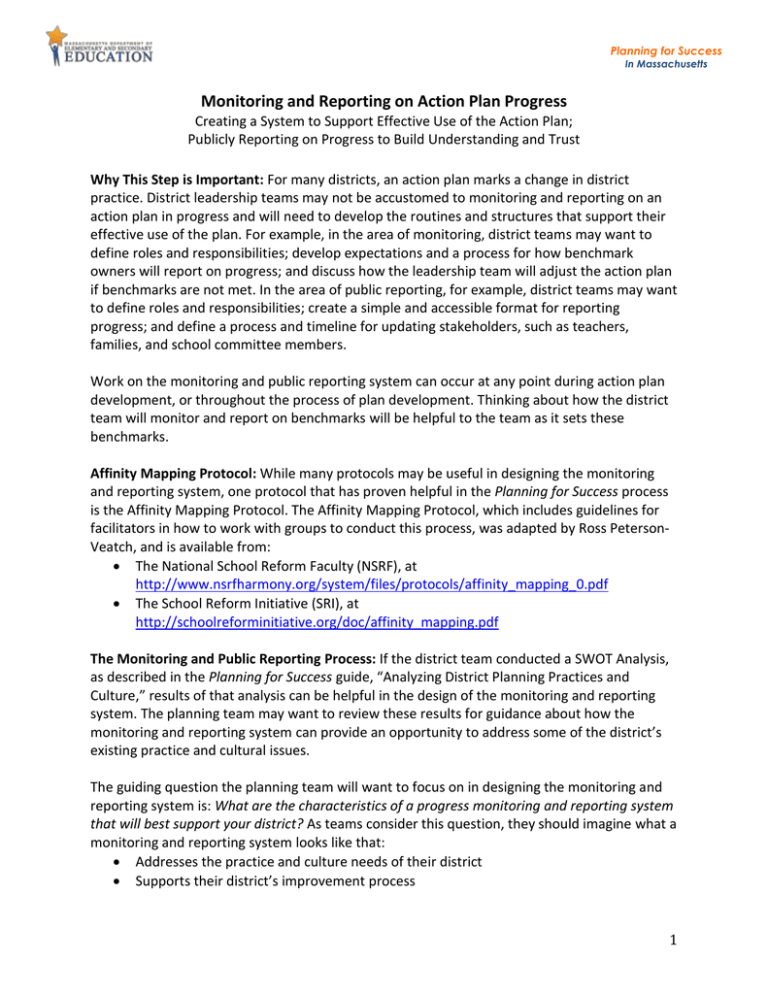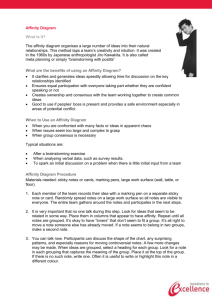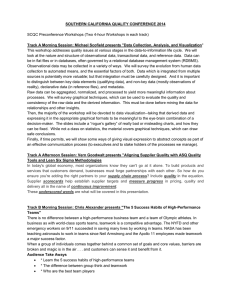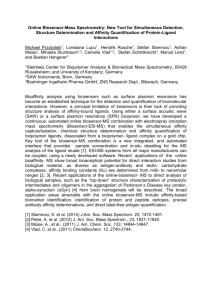PfS APMonitoringSystem
advertisement

Planning for Success In Massachusetts Monitoring and Reporting on Action Plan Progress Creating a System to Support Effective Use of the Action Plan; Publicly Reporting on Progress to Build Understanding and Trust Why This Step is Important: For many districts, an action plan marks a change in district practice. District leadership teams may not be accustomed to monitoring and reporting on an action plan in progress and will need to develop the routines and structures that support their effective use of the plan. For example, in the area of monitoring, district teams may want to define roles and responsibilities; develop expectations and a process for how benchmark owners will report on progress; and discuss how the leadership team will adjust the action plan if benchmarks are not met. In the area of public reporting, for example, district teams may want to define roles and responsibilities; create a simple and accessible format for reporting progress; and define a process and timeline for updating stakeholders, such as teachers, families, and school committee members. Work on the monitoring and public reporting system can occur at any point during action plan development, or throughout the process of plan development. Thinking about how the district team will monitor and report on benchmarks will be helpful to the team as it sets these benchmarks. Affinity Mapping Protocol: While many protocols may be useful in designing the monitoring and reporting system, one protocol that has proven helpful in the Planning for Success process is the Affinity Mapping Protocol. The Affinity Mapping Protocol, which includes guidelines for facilitators in how to work with groups to conduct this process, was adapted by Ross PetersonVeatch, and is available from: The National School Reform Faculty (NSRF), at http://www.nsrfharmony.org/system/files/protocols/affinity_mapping_0.pdf The School Reform Initiative (SRI), at http://schoolreforminitiative.org/doc/affinity_mapping.pdf The Monitoring and Public Reporting Process: If the district team conducted a SWOT Analysis, as described in the Planning for Success guide, “Analyzing District Planning Practices and Culture,” results of that analysis can be helpful in the design of the monitoring and reporting system. The planning team may want to review these results for guidance about how the monitoring and reporting system can provide an opportunity to address some of the district’s existing practice and cultural issues. The guiding question the planning team will want to focus on in designing the monitoring and reporting system is: What are the characteristics of a progress monitoring and reporting system that will best support your district? As teams consider this question, they should imagine what a monitoring and reporting system looks like that: Addresses the practice and culture needs of their district Supports their district’s improvement process 1 Planning for Success In Massachusetts Supports their community’s understanding of and commitment to that process Examples of monitoring and reporting system characteristics that team members might identify could include “easily updatable,” “realistic reporting dates,” “monthly sharing of progress in leadership meetings,” or “feedback vehicle that keeps the pulse on how all stakeholders are feeling.” Such characteristics might then be grouped by the team into categories such as “documentation,” “timelines,” “leadership behavior,” and “culture.” The process below describes how to use the Affinity Mapping Protocol in designing a monitoring and public reporting system. 1. Review results from the SWOT Analysis, if conducted, to refresh the team’s memory of the strengths, weaknesses, opportunities, and threats the team identified in relation to the district’s planning practices and culture. 2. Pose the guiding question for group consideration and discussion. 3. Organize into small mixed groups of 4-5 participants each. Follow the Affinity Mapping Protocol. With this protocol, participants will list one system characteristic on each stickie, post their stickies on chart paper, and then regroup all participants’ stickies to create categories. Allow approximately 45 minutes for small groups to conduct the Affinity Mapping Protocol. 4. Reconvene as a whole group. Ask the facilitators of all small groups to share the categories their groups created. As a group, identify common themes across categories. 5. Collect the charts/documented work from the recorders of all small groups. Type up and distribute results of the Affinity Mapping process to all team members. Use results as the basis for drafting a monitoring and reporting system. Time Required: This session requires approximately 1.5 hours to complete, depending on the number of participants and small groups that will report out. Text for Facilitator Presentation Slides: Some suggested text for presentation slides to support developing an action plan monitoring and reporting system is included below. Slide 1: SWOT Results What do your SWOT reflections say about what you would like to see in a monitoring and reporting process? Slide 2: Designing the Monitoring Process What are the characteristics of a progress monitoring and reporting system that will best support your district? Imagine what a monitoring and reporting system will look like that: o Addresses the practice and culture needs of your district o Supports your district’s improvement process o Supports your community’s understanding of and commitment to that process 2 Planning for Success In Massachusetts Slide 3: Affinity Mapping Protocol Each participant takes 5 to 10 stickies Working silently, write one idea/sticky note One by one, each participant adds their stickies to the chart As participants add, they should regroup stickies to create categories Once all stickies are posted, talk with one another and label the categories Identify a spokesperson to share your work Adapted by Ross Peterson-Veatch, http://schoolreforminitiative.org/doc/affinity_mapping.pdf 3




